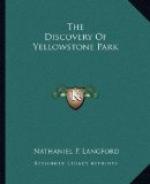The mountain on which we stood was the most westerly peak of a range which, in long extended volume, swept to the southeastern horizon, exhibiting a continuous elevation more than thirty miles in width, its central line broken into countless points, knobs, glens and defiles, all on the most colossal scale of grandeur and magnificence. Outside of these, on either border, along the entire range, lofty peaks rose at intervals, seemingly vying with each other in the varied splendors they presented to the beholder. The scene was full of majesty. The valley at the base of this range was dotted with small lakes. Lakes abound everywhere—in the valleys, on the mountains and farther down on their slopes, at all elevations. The appearance of the whole range was suggestive of the existence, ages since, of a high plateau on a level with these peaks (which seemed to be all of the same elevation), which by the action of the water had been cut down in the intervals between the peaks into deep gorges and canons. The sides of the mountains formed in many places a perpendicular wall from 600 to 1,000 feet in height.
This range of mountains has a marvelous history. As it is the loftiest, so it is probably the most remarkable lateral ridge of the Rocky range. In the expedition sent across the continent by Mr. Astor, in 1811, under command of Captain Wilson P. Hunt, that gentleman met with the first serious obstacle to his progress at the eastern base of this range. After numerous efforts to scale it, he turned away and followed the valley of Snake river, encountering the most discouraging disasters until he arrived at Astoria.[O]
I have read somewhere (I think in Washington Irving’s “Astoria” or “Bonneville’s Adventures”) that the Indians regard this ridge of mountains as the crest of the world, and that among the Blackfeet there is a fable that he who attains its summit catches a view of the “Land of Souls” and beholds the “Happy Hunting Grounds” spread out below him, brightening with the abodes of the free and generous spirits.




